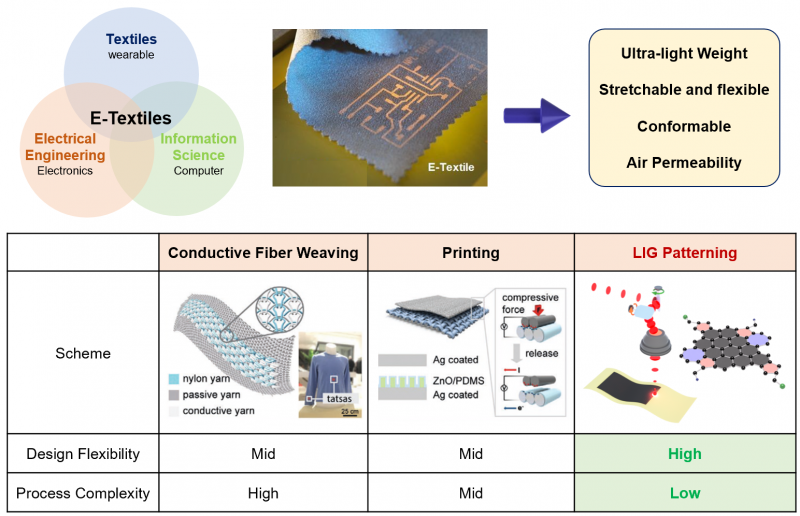For the first time, multimodal graphene-based electronic textiles (e-textiles) have been created, paving the way for tailored and customized e-textiles.
 Introduction on e-textiles and (below) comparison of methods for manufacturing e-textiles. Image Credit: Korea Institute of Machinery and Materials (KIMM)
Introduction on e-textiles and (below) comparison of methods for manufacturing e-textiles. Image Credit: Korea Institute of Machinery and Materials (KIMM)
A collaborative research team led by Principal Researcher Soongeun Kwon from the Department of Nano Manufacturing Technology at the Korea Institute of Machinery and Materials (KIMM) and Professor Young-Jin Kim from the Department of Mechanical Engineering at the Korea Advanced Institute of Science and Engineering (KAIST), has successfully pioneered the development of customized graphene-based e-textiles, marking a global first. The results of this groundbreaking work have been published in ACS Nano.
In contrast to the conventional methods that rely on toxic chemicals or optical masks for patterning, the collaborative research team employed laser-direct patterning technology to create laser-induced graphene (LIG) on e-textiles. This approach led to the successful production of graphene-based e-textiles.
Traditional methods for manufacturing e-textiles have typically involved coating fabrics with conductive ink to render them electrically conductive and then weaving them with standard fabrics or incorporating a thin functional layer onto regular fabrics. These methods are associated with limited design flexibility and a complex manufacturing process. Additionally, there is a risk of harmful chemicals being released during production, which can hinder mass production.
With this newly developed technology, it becomes possible to create high-quality LIG materials with world-class electrical conductivity by simply irradiating a laser onto the surface of fabrics. A key advantage of this approach is its eco-friendly nature, as it eliminates the need for chemical use or additional processing in producing e-textiles. Furthermore, the outstanding electrical conductivity of LIG electrodes has been achieved by applying femtosecond laser processing technology.
This innovative technology holds promise for the future, with potential applications in the manufacturing of industrial and military clothing for personal health management, as well as the production of customized "smart" garments within the healthcare sector.
This technology has been developed by analyzing the structures of generic fabrics and realizing them as graphene-based materials that have advanced features of optimal e-textiles. This technology is significantly meaningful in that it allows for the mass production of customized e-textiles using an environment-friendly and simple method.
Soongeun Kwon, Principal Researcher, Department of Nano Manufacturing Technology, Korea Institute of Machinery and Materials
This research was conducted with the support of the project aimed at developing nano-based "Omni-TEX" manufacturing technologies, which is one of the fundamental projects undertaken by KIMM.
Journal Reference:
Yang, D., et al. (2023). Multimodal E-Textile Enabled by One-Step Maskless Patterning of Femtosecond-Laser-Induced Graphene on Nonwoven, Knit, and Woven Textiles. ACS Nano. doi.org/10.1021/acsnano.3c04120.